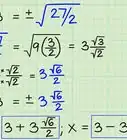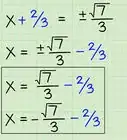This article was co-authored by David Jia. David Jia is an Academic Tutor and the Founder of LA Math Tutoring, a private tutoring company based in Los Angeles, California. With over 10 years of teaching experience, David works with students of all ages and grades in various subjects, as well as college admissions counseling and test preparation for the SAT, ACT, ISEE, and more. After attaining a perfect 800 math score and a 690 English score on the SAT, David was awarded the Dickinson Scholarship from the University of Miami, where he graduated with a Bachelor’s degree in Business Administration. Additionally, David has worked as an instructor for online videos for textbook companies such as Larson Texts, Big Ideas Learning, and Big Ideas Math.
wikiHow marks an article as reader-approved once it receives enough positive feedback. This article received 15 testimonials and 100% of readers who voted found it helpful, earning it our reader-approved status.
This article has been viewed 181,999 times.
One of the most important skills an algebra student learns is the quadratic formula, or With the quadratic formula, solving any quadratic equation of the form becomes a simple matter of substituting the coefficients into the formula. While simply knowing the formula is often enough for many, understanding how it's derived (in other words, where it comes from) is another thing entirely. The formula is derived via "completing the square" that has other applications in math as well, so it is recommended that you be familiar with it.
Steps
-
1Start with the standard form of a general quadratic equation. While any equation with an term in it qualifies as quadratic, the standard form sets everything to 0. Remember that are coefficients that can be any real number, so don't substitute any numbers in for them - we want to work with the general form.[1]
- The only condition is that because otherwise, the equation reduces to a linear equation. See if you can find general solutions for the special cases where and where
-
2Subtract from both sides. Our goal is to isolate To start, we move one of the coefficients to the other side, so that the left side only consists of terms with in it.[2]Advertisement
-
3Divide both sides by .[3] Note that we could've switched this and the previous step, and still arrived at the same place. Remember that dividing a polynomial by something means that you divide each of the individual terms. Doing so makes it easier for us to complete the square.
-
4Complete the square. Recall that the goal is to rewrite an expression as where is any coefficient. It may not immediately be obvious to you that we can do this. To see it more clearly, rewrite as by multiplying the term by We can do this because multiplying by 1 does not change anything. Now we can clearly see that in our case, so we are only missing the term. Therefore, in order to complete the square, we add that to both sides - namely, Then, of course, we factor.[4]
- Here, it is clear why since is in the denominator, and you cannot divide by 0.
- If you need to, you can expand the left side to confirm that completing the square works.
-
5Write the right side under a common denominator. Here, we want both denominators to be so multiply the term by [5]
-
6Take the square root of each side. However, it is essential that you recognize that in doing so, you are actually doing two steps. When you take the square root of you do not get You actually get its absolute value, This absolute value is critical in getting both roots - simply putting square roots over both sides will only get you one of the roots.[6]
- Now, we can get rid of the absolute value bars by putting a on the right side. We can do this because the absolute value does not distinguish between positive and negative, so they are both valid. This tidbit is why the quadratic equation allows us to get two roots.
- Let's simplify this expression a bit further. Since the square root of a quotient is the quotient of the square roots, we can write the right side as Then we can take the square root of the denominator.
-
7
-
8Write the right side under a common denominator. This nets the quadratic formula, the formula that solves any quadratic equation in standard form. This works for any and outputs an that can be real or complex. To confirm that this process works, simply follow the steps of this article in reverse order to recover standard form.[8]
Community Q&A
-
QuestionWhat is the quadratic formula?
 DonaganTop AnswererShown in the introduction above, it's a tool used to solve a quadratic equation that is not easily solved by factoring.
DonaganTop AnswererShown in the introduction above, it's a tool used to solve a quadratic equation that is not easily solved by factoring. -
QuestionWhat is the cubic formula?
 DonaganTop AnswererIt's a formula for solving cubic equations. Take a look at math.vanderbilt.edu/schectex/courses/cubic/.
DonaganTop AnswererIt's a formula for solving cubic equations. Take a look at math.vanderbilt.edu/schectex/courses/cubic/. -
QuestionWhy is there a plus or minus in the quadratic formula?
 LinnieTop AnswererWhen you take the square root of both sides of the equation, you need a plus or minus sign before the right side to show that the positive value squared equals (x+b/2a)² and that the negative value squared equals (x+b/2a)².The square root of x², for example, does not equal x but rather equals the absolute value of x, so the right side may be positive or negative.
LinnieTop AnswererWhen you take the square root of both sides of the equation, you need a plus or minus sign before the right side to show that the positive value squared equals (x+b/2a)² and that the negative value squared equals (x+b/2a)².The square root of x², for example, does not equal x but rather equals the absolute value of x, so the right side may be positive or negative.
References
- ↑ https://www.chilimath.com/lessons/intermediate-algebra/derive-quadratic-formula/
- ↑ https://www.chilimath.com/lessons/intermediate-algebra/derive-quadratic-formula/
- ↑ https://www.purplemath.com/modules/sqrquad2.htm
- ↑ https://www.mathsisfun.com/algebra/quadratic-equation-derivation.html
- ↑ https://www.purplemath.com/modules/sqrquad2.htm
- ↑ https://virtualnerd.com/algebra-1/quadratic-equations-functions/discriminant-quadratic-formula/quadratic-formula/quadratic-formula-derivation
- ↑ https://mathbitsnotebook.com/Algebra1/Quadratics/QDderive.html
- ↑ https://virtualnerd.com/algebra-1/quadratic-equations-functions/discriminant-quadratic-formula/quadratic-formula/quadratic-formula-derivation
About This Article
To derive the quadratic formula, start by subtracting c from both sides of the equation. Then, divide both sides by a, and complete the square. Next, write the right side of the equation under a common denominator, and take the square root of each side. Finally, isolate x, and write the right side under a common denominator again. To see examples of how to derive the quadratic formula, read on!






































-Step-31-Version-2.webp)
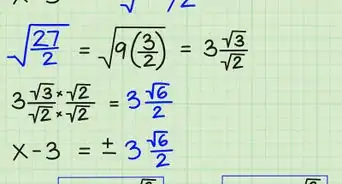

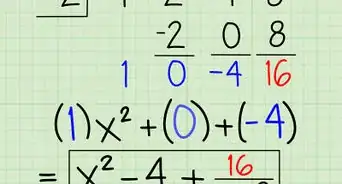

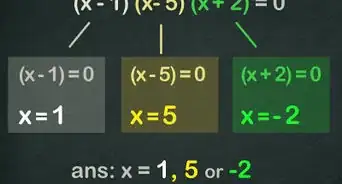
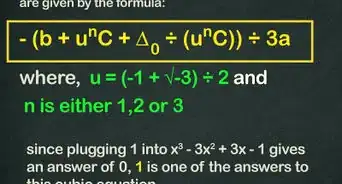


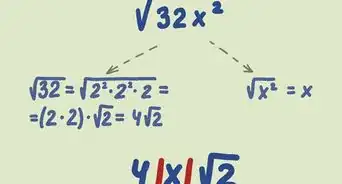
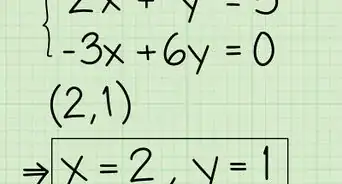

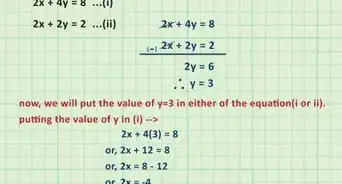
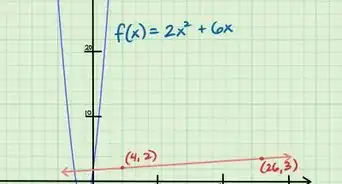









-Step-31-Version-2.webp)
